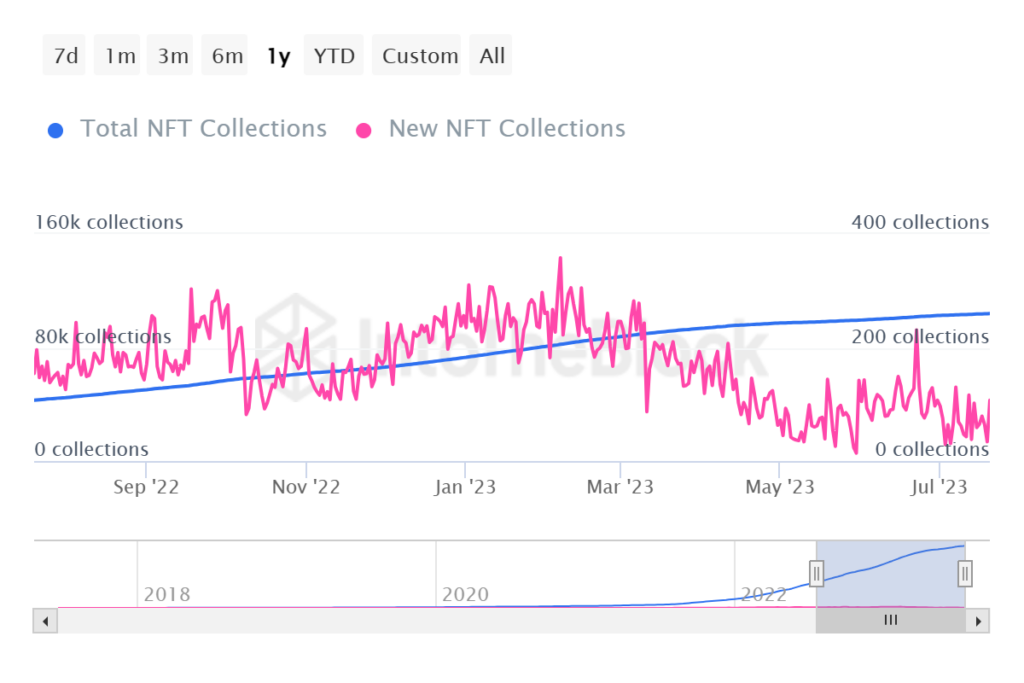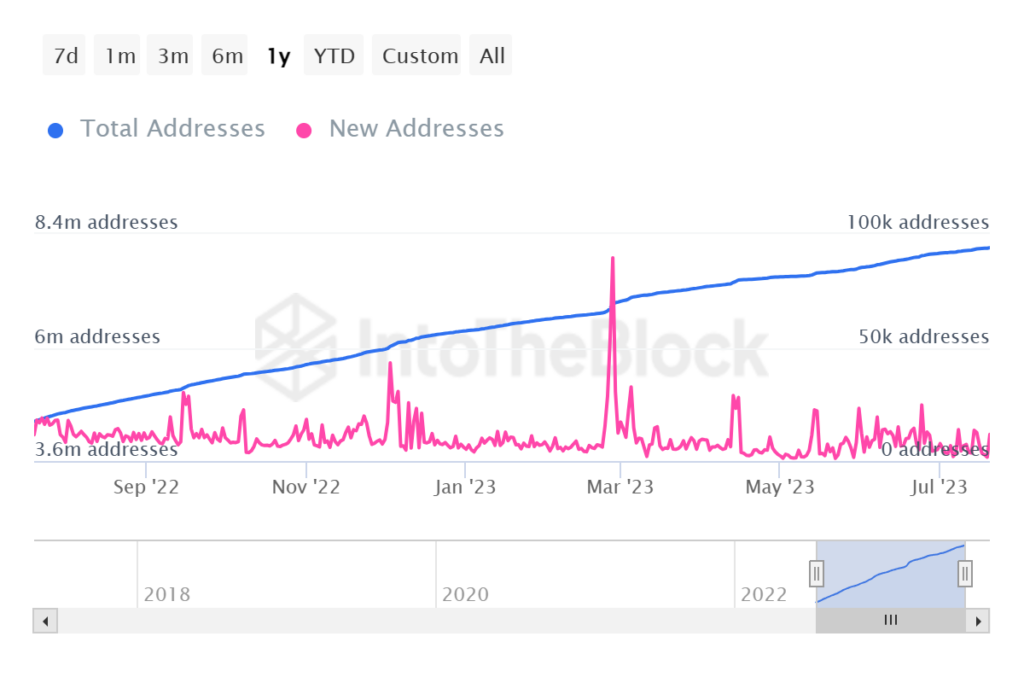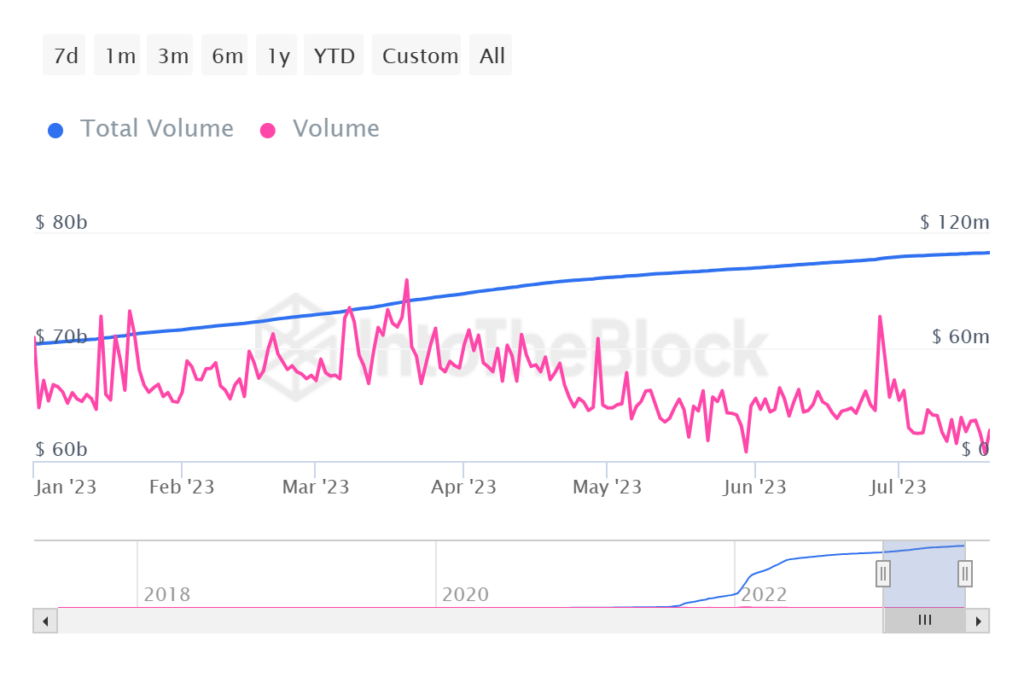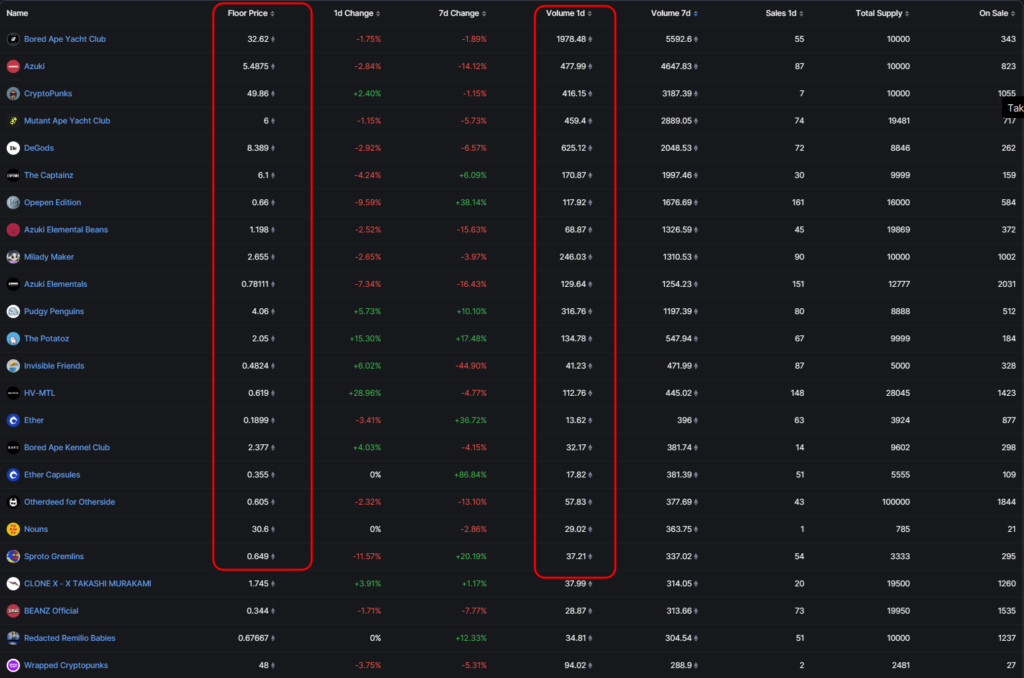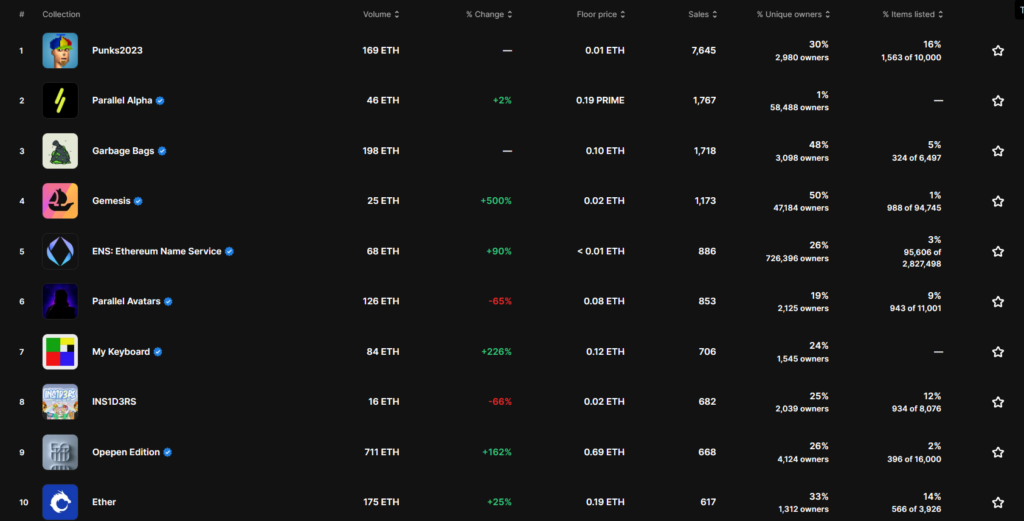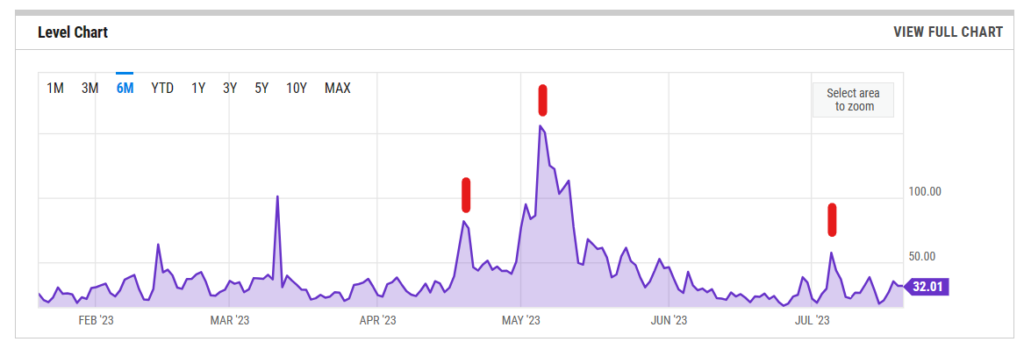The trading volume of Ethereum NFTs is $78 billion, and the total number of collections is 104,000. The majority of trading volume happens in some of the most expensive collections while the long tail needs to succumb to the high gas cost. It’s also worth noting that most NFTs have very little value and haven’t changed hands for a long time. Here we show how these ERC-721 could get a new life on PulseChain and what the real value proposition of that chain is.
NFT market on Ethereum
The number of NFT collections on Ethereum increased by 300% with respect to the last year, and the number of addresses that ever used NFTs grew by almost 100%.
The trading volume jumped from $64 billion to $78 billion.
The numbers are staggering considering that we are in a bear market. The daily volume of $15 -35 million is generated mostly by collections with a floor price higher than 1 ETH. What this means is that a small number of high value collections move the market made up of 104k NFT collections traded on Ethereum. The majority of NFTs are lingering around for different reasons. One of them is high gas fees, which make most NFT valueless.
Although the market is moved by large sales, the activity is also in more affordable NFTs. When we look at the trending NFTs on OpenSea, we notice that the floor price is very low but the number of owners is high. The floor hasn’t exceeded 0.2 ETH for most of the top 10 trending collections in the past 7 days. They are mostly new collections. One sale of a rare CryptoPunk or Bored Ape can make up for a daily volume of thousands of NFTs. These sales create volume but aren’t as frequent as transactions of smaller size.
The cost of flipping
Trading NFTs on Ethereum comes at a cost. The cost is an Ethereum gas fee and a royalty fee. While the royalty fee is on average the same, gas prices can significantly influence the price of a NFT. It’s for a reason that OpenSea or Blur are consistently some of the biggest gas guzzlers on Ethereum.
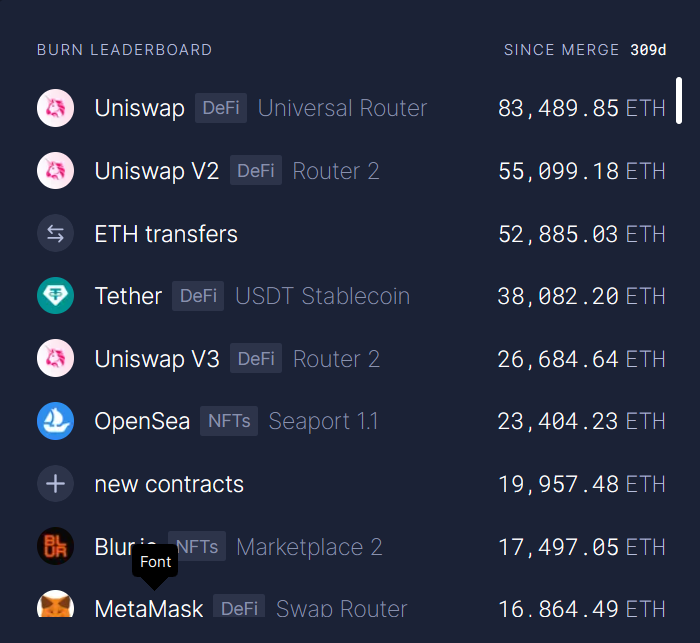
Trading NFTs is more expensive than sending a normal ERC-20 transaction. It involves more complex smart contract interactions and requires more gas. Gas has a huge impact on NFT prices, especially during drops.
New collections are often subject to gas spikes because users bid for the block space at the same time. In most cases, the high gas cost to mint a NFT is just a useless expense that adds no value to the NFT. We observe that in the world of NFTs, finding cheap deals and selling them right after is a good opportunity to gain from price appreciation.
Buying and selling NFTs at the lowest cost to extract the most value from a speculative trade is the main goal. This is especially important for low value NFTs. The added sale cost of a high value NFT like a CryptoPunk makes little to no difference, but for a low value NFT, it can be everything.
NFT trading is related to the gas price. When gas prices are high, NFT trading halts. The historical gas price chart shows that on April 20, May 5, and July 5, gas prices spiked, which reflected a reduced number of NFT trades.
The cost of ERC721
Deploying an ERC721, minting new NFTs, and transferring them is, in general, more expensive than regular ERC20 transfers.
The deployment cost of a contract is up to the developer, but more creators always decide to deploy ERC721 because there are more tools to do it easily. Minting NFTs costs gas because of the required computational work to update the storage to add new NFTs.
This gas fee is getting higher as the Ethereum blockchain gains more adoption. The state of the ledger grows, and more computation is needed for all the tasks. Improvements are made to create new smart contracts with higher gas efficiency, but this doesn’t change the fact that the 104k collections worth $78 billion can’t be upgraded and will be traded as such.
Ethereum NFT copies on PulseChain
Many ERC721 NFTs lost value due to the price of gas. The difference between the gas price and the NFT price is minimal, or in many cases, the cost to mint or trade exceeds the value, so they become almost useless. Entire collections linger without the possibility of doing anything with them. This is where PulseChain comes in as a new platform because each NFT on PulseChain is a straight copy of an Ethereum NFT.
PulseChain is a faster and cheaper fork of Ethereum with a full copy of its entire state. The full state of a blockchain represents the current state of all accounts, smart contracts, balances, and other data recorded on the blockchain, as well as the history of all transactions and interactions that have taken place.
Every smart contract with the history of every transaction can be found on PulseChain. ERC20 becomes PRC20, and ERC721 becomes PRC721. Every Ethereum user who had anything in their wallet at the snapshot time on May 10th can find all the ERC20 tokens and NFTs on PulseChain. It’s enough to connect a wallet, change the network to PulseChain, and check for the tokens that were in the wallet at that time. Read this guide for instructions.
Not every token will have the same value on PulseChain as it did on Ethereum, but it’s definitely worth checking if there is some free money on the other side.
NFTs are a special case because of their limited quantity and different market dynamics and value propositions, but most NFTs that have been outpriced by the cost of ETH gas can have a new life on PulseChain. These are the same NFTs that don’t have to be transferred and don’t require any action on Ethereum so they don’t incur any cost to the owner. The NFT owner simply opens the wallet and lists them up for sale at a negligible gas cost on PulseChain. Trading fees on PulseChain become a no-issue, and the long tail of PRC721 can transform into a thriving market. Owners can adopt different marketing tactics to attract attention to their collection on PulseChain. Burning an entire collection on Ethereum and transferring community and value to Pulse may be one of them.
NFT market on PulseChain
PulseChain has no proper NFT marketplace just yet. The indexing of the Ethereum state is almost finished, though, and soon the NFT marketplace with the entire history of NFTs will be available on NFTonPulse.io. This will be the first NFT marketplace on PulseChain, comparable to OpenSea or Blur on Ethereum, and will host all kinds of collections, not just a single one like PulsePunks. NFTonPulse is currently running a sacrifice phase where users can sacrifice some ETH or other tokens to gain points. HTP tokens will be given to each sacrificer, and it will be possible to stake them to gain passive income. HTP tokens are like equity in the NFTonPulse platform because they will give stakers a share of the entire trading volume fee. The difference between OpenSea and Blur is that HTP stakers gain PLS from every action on the marketplace.
When is the end of indexing
Indexing is a difficult process. Indexing is the process of organising and storing data in a way that allows for efficient and quick retrieval of information from the entire blockchain history. It’s crucial for blockchain systems to provide fast and reliable access to data, especially in dapps that require real-time information. It’s essential to retrieve account balances, transaction history, smart contract information to be able to query the blockchain to access specific data, like, for example, NFT token IDs and all the information connected with them.
Each ERC721 is a smart contract, and smart contracts are programs written in Solidity, compiled to the Ethereum Virtual Machine (EVM) bytecode, and then deployed on Ethereum, where they run on all nodes. Copied PRC721s need to be indexed to be read and presented to users as NFTs. The indexing is almost done, though, and once the sacrifice phase is also finished and the audit is completed, the users will be able to trade their Ethereum NFTs on NFTonPulse.
Conclusion
The value proposition of PulseChain is a faster blockchain with the full state of Ethereum and very cheap gas fees. Every Ethereum NFT holder is automatically a holder of the same NFT on PulseChain. NFTs that lost value on Ethereum due to expensive gas costs can be traded on PulseChain for next to nothing while gaining first-mover advantage at the same time. Whichever collection owner decides to venture into Pulse will get the attention of the entire community on a new marketplace like NFTonPulse. This may be a hit-or-miss try, but it costs almost no gas to try.

